I said that for this Sunday’s supper I would make a broccoli dish from Apicius’ 2nd century and indeed I did. I would do it differently next time (since  the recipe was pretty sketchy). for some hints about how to use all the broccoli that is coming in.work De re coquinaria
the recipe was pretty sketchy). for some hints about how to use all the broccoli that is coming in.work De re coquinaria
The recipe was from De re coquinaria, Apicius’ 2nd century cookbook in a modernized edition by John Edwards called The Roman Cookery of Apicius, I could make coliculi elixati, “Broccoli and Cabbage in Coriander Wine Sauce”. I had everything in the garden, with the exception of the cumin.
There wasn’t much to the recipe except to put cooked broccoli in the concoction they designated, “boiled wine” and some herbs and onion. Just about the prevalent ingredient in ancient Roman fare was pepper, and of course garum. I didn’t use garum, but I did use pepper. I think I could have used more. The basic idea is to seethe your broccoli in this cooking fluid, which has onion, coriander, cumin and pepper. The fluid itself was a sweet wine I reduced to less than half. I should have reduced it more and increased the spices.

The main course was a chicken recipe from Julia Child’s Mastering the Art of French Cooking, Poulet Sauté aux Herbes de Provence Chicken sauteed with Herbs and Garlic, Egg Yolk and Butter Sauce. The recipe calls for thyme or savory, I and used both.
The recipe as described in the book:
Basil, thyme or savory, a pinch of fennel, and a bit of garlic give this sauté a fine Provencal flavor that is even more pronounced if your herbs are fresh. The sauce is a type of hollandaise, as the herbal, buttery pan juices are beaten into the egg yolks to make
a thick and creamy liaison. Serve this dish with potatoes sauteed in butter or potato crepes, broiled tomatoes and a chilled rosé wine.
The total time I used was about an hour of really intense work, which included setting the table in the gaps.
I would not have been any fun to talk with during that first half hour, for sure. Then things settled in and didn’t get bad until the last 5 minutes.
I brought in lots of coriander (= ciilantro) which had gone to seed. I wanted the seeds. Next time I will also use leave of fresh cilantro.
Now to shake of the seeds and store them against the next time.
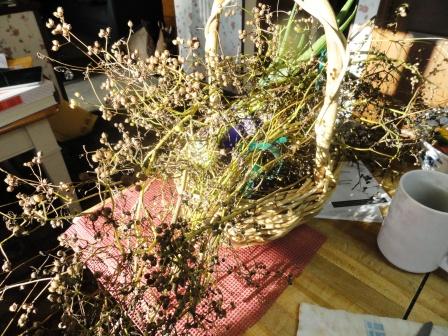
Grinding some coriander.
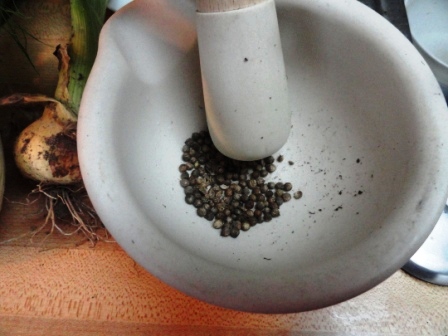
Reducing the wine.
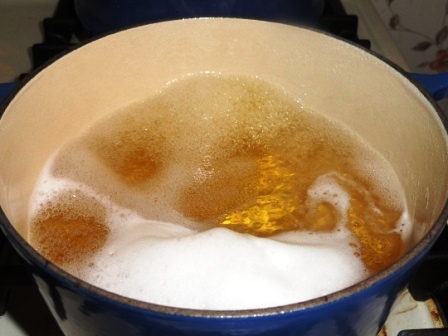
The seething mixture, includes olive oil.
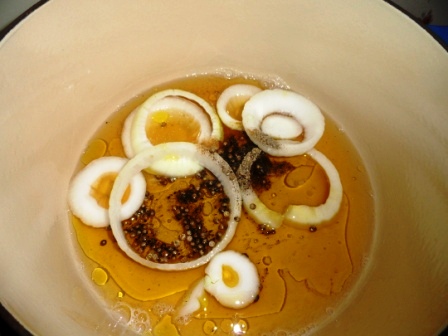
The beginning of the preparation of the chicken is not so interesting in itself.
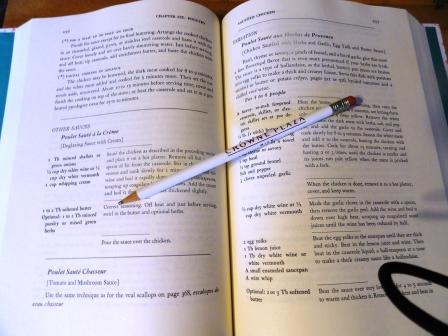
Brown the chicken in butter, take out the white meat at a certain point and season the dark and keep cooking with the herbs.
Then add the white back in and finish cooking.
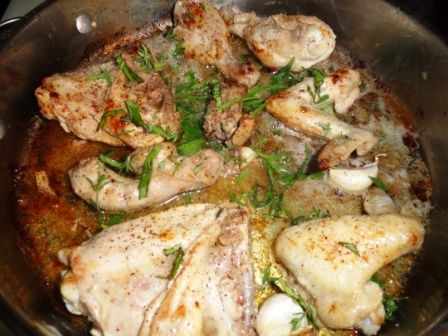
Then the fun starts.
One of the things you added when the white meat came out the first time were three cloves of unpeeled garlic.
Now that all the chicken is cooked and out of the pan, you mash the garlic and take out the skins.
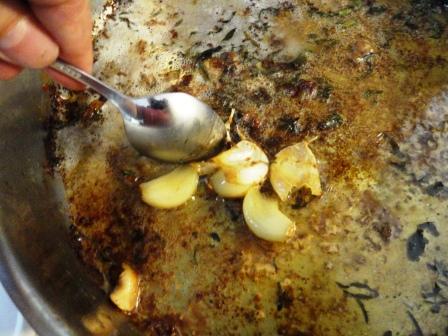
Deglaze with white wine or vermouth. I used vermouth. Reduce.
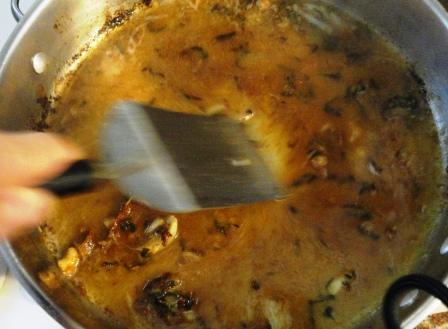
If you have other things going, you need to pay attention, because it was at this point that I forgot to keep my eye on the hashbrowns I decided to make.
You make a sauce from the pan juices along the lines of a Hollandaise.
This means use set up a double-boiler and start beating the juices into egg yolks.
Cook it as you go to thicken it.
I strained the juices a bit before I started, but I wouldn’t have had to.
Add more herbs.
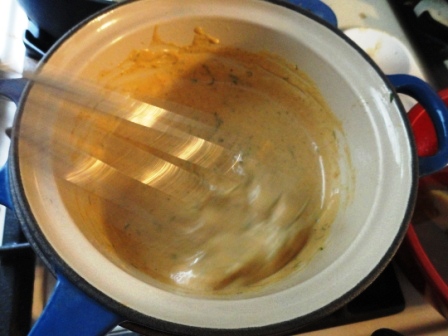
Put it on the platter and haul it outside! Dark hashbrowns on the left, of course.
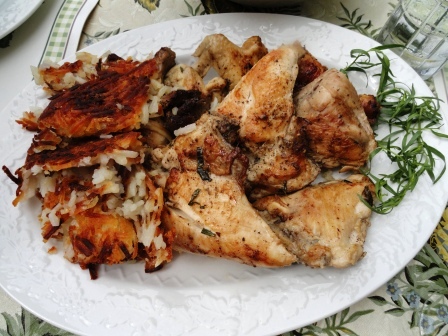
Plated with ancient Roman broccoli.
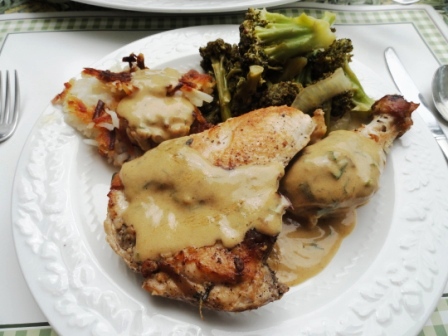
The broccoli…. I don’t know what to say. The recipe was perfectly sketchy.
I need to try this again, to get into the theory of it. It just didn’t seem right to me.
Don’t get me wrong. It was good.
First, the broccoli discolored, which in itself doesn’t bother me too much, but I think that having a more intense and reduced fluid and slower cook time will help.
Also, I will steam the broccoli above the mixture before I put it in to blend the flavors.
And it must be more intense. I need to reduce far more than the recipe suggested. We have to consider what ancient Roman wine was like. This needed a thicker and more rasiny impact. And I will use also more of the spices. Also, I will probably also add sliced cabbage.
I think I know what this recipe is about, but today… it wasn’t quite there. Good, but not yet right.
The chicken was tender and the sauce intense with a perfect balance of the herbs. The hashbrowns were a good choice, and they were not burned, though they came close while I was doing the sauce. Gotta remember that and set up the time line so they are done and the sauce is the last thing I have to prepare.
For dessert we had crisp apples and a soft cheese and some little cookies with very strong coffee.
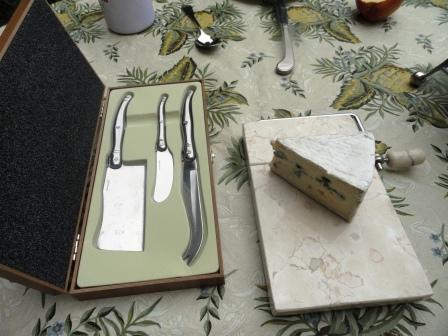
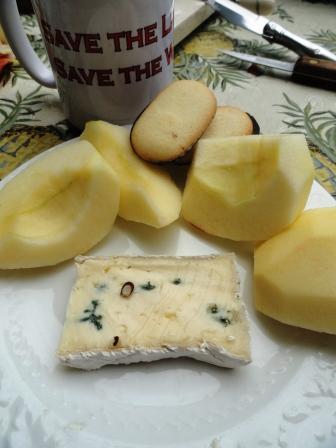
Here is a shot of the wine we had with the meal.
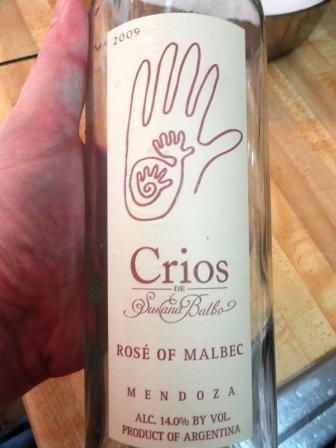
Thus, Sunday supper.
Penjing and the bonsais were banished to the kiddie table.
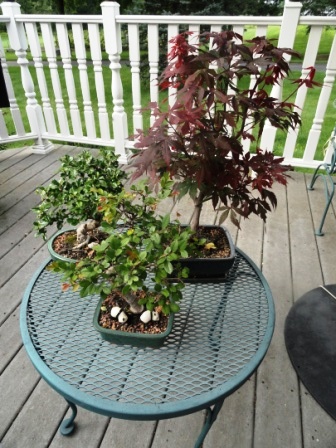
Penjing, protesting the marginalization, is putting on a show with little white flowers.
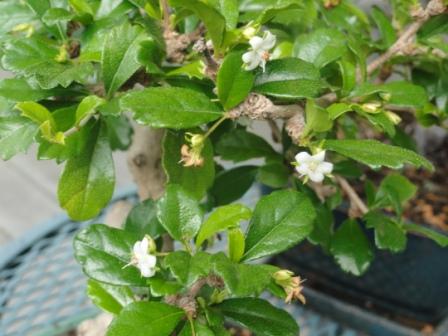
Once again, make plans for Sunday meals with others.
Families who eat together tend to have stronger bonds.
Invitations to meals, especially to those who are alone, can be a great source of consolation, a real work of mercy.
From John Paul II’s Dies Domini:
72. The Eucharist is an event and programme of true brotherhood. From the Sunday Mass there flows a tide of charity destined to spread into the whole life of the faithful, beginning by inspiring the very way in which they live the rest of Sunday. If Sunday is a day of joy, Christians should declare by their actual behaviour that we cannot be happy “on our own”. They look around to find people who may need their help. It may be that in their neighborhood or among those they know there are sick people, elderly people, children or immigrants who precisely on Sundays feel more keenly their isolation, needs and suffering. It is true that commitment to these people cannot be restricted to occasional Sunday gestures. But presuming a wider sense of commitment, why not make the Lord’s Day a more intense time of sharing, encouraging all the inventiveness of which Christian charity is capable? Inviting to a meal people who are alone, visiting the sick, providing food for needy families, spending a few hours in voluntary work and acts of solidarity: these would certainly be ways of bringing into people’s lives the love of Christ received at the Eucharistic table.
And don’t forget to pray before and after meals.
BEFORE: Benedic, Domine, nos et haec tua dona quae de tua largitate sumus sumpturi. Per Christum Dominum nostrum. Amen.
AFTER: Agimus tibi gratias, omnipotens Deus, pro universis beneficiis tuis, qui vivis et regnas in saecula saeculorum. Amen.
and… Fidelium animae per misericordiam Dei requiescant in pace. R. Amen.



































Excellent! This looks wonderful, Fr.Z! I’m thinking of pulling my copy of this recipe off the shelf and giving it a go next Sunday.
I know what you mean about the “intense” work of some recipes. I once called my kitchen my “oratory” to a close friend–sometimes prayer, as well as cooking, gets to be a struggle…but what peace often follows!
I recognize those cookies: Pepperidge Farm Milano’s! Good choice!
Jay: They are. One is a minty cookie and the other is chocolaty.
They are great with strong coffee (and when you don’t know what else to do and desserts are at the bottom of your list of interests).
Father: Nice, honest, cooking critique. Write down the lessons learned! I write in all my cookbooks and recipe cards alongside the recipes. Sometimes my notes are alongside my Mom’s or my Grandmother’s (both of them) notes-an occasion that always make me wistful but then the thought of 3 generations of women trying the same recipes and tweaking what works for them makes me smile.
I love those cookies.
Another great post, Father! You make it look easy! Thank you also for the quote from Ven. John Paul’s “Dies Domini”. It is very important for the modern Catholic family to reestablish the traditional “Sunday Dinner”!
Looks like a job well done. I know exactly what you mean when you say it’s so crazy preparing everything by yourself. We often invite our clergy – either the FSSP that drive 2+ hours to say our Mass, or our more local diocesan priest who says our EF Mass – to dinner, and I’m all but pulling my hair out trying to get it all done. I love to make everything homemade.
I was a bit surprised by your choice of hashbrowns, though. Aren’t potatoes new world ? Just askin’…..I was hoping that you would make my suggestion of potato tatin. Maybe next time.
I would like to send you some of our dried oregano from our plant here in Calif. We are getting ready to harvest and will dry it. The plant came from my husband’s family in Spain many, many years ago when the family emigrated. It’s the most incredible oregano any of us have ever used. How does one get that to you ?
How we live the rest of Sunday… I did a few hours work in the garden. ‘Servile work’? – but not a grave sin I think. [Not a sin at all, as a matter of fact, particularly if you enjoy gardening!] Gotta say, what I normally do on Sundays is dictated by the fact that I can’t do those things during the week.
Father, your broccoli suggestions sound very good; I shall try it. Thank you.
I just wish I could do a decent hollandaise. I always make a mess of egg emulsion sauces.
Best post ever!! Although, I think I’ll stick to the broccoli and noodle recipe on the cream of mushroom soup can.
With a Provençal recipe, you must drink a Provence’s rosé.
I recommend you the “Chateau Sainte Roseline” rosé 2007.
Sainte Roseline is a popular holy woman of the Middle Age.
The wine is grown close to her birth home.
Lucy: Aren’t potatoes new world ?
I am not sure what your point is. The suggestion with the recipe (see original post) was for some super heavy potato crepes. The hashbrowns were a less rich compromise. Perhaps you were under the impress that I was trying to make an ancient meal? No. Just the broccoli recipe was ancient.
Galactic: I think I’ll stick to the broccoli and noodle recipe on the cream of mushroom soup can.
You know, it doesn’t take much more effort to do something a little more adventurous.
albizzi: With a Provençal recipe, you must drink a Provence’s rosé.
I agree… if you can get one. I couldn’t.
I really wanted a Bandol.
Thank you once again Father for your meal in story pictures. The chicken looks wonderful in the pan and on the plate, I’ll bet the aromas were amazing. The dessert looks good as well.
I may have to try the chicken, I’m a little leary of the sauce, though. (Because I’m not sure I could do it, not because it doesn’t sound tasty.)
I hope the bonsai trees have gotten over being shunted to the kiddie table.
Thank you Father for all this effort on our behalf. You certainly could be making these yummy meals and no one would even know. I’m sure you are inspiring many to try new things and to share with others on Sundays or whenever they are able.
Another interesting cooking adventure from Father Z!
Looking at the chicken, broccoli, and hash browns is making me hungry!
I thought those cookies were Pepperidge Farm Milanos! I like them, too!
I’m still not much of a cook, however….since I live alone, I go out to eat more often than eating at home, particularly on hot days. The kitchen faces west in my house, and when it’s hot out, it’s an ordeal even with the windows open!
irishgirl: Cook at night?
The dinner looks great, inspite of the “hashed – too – brown”s. Nice choice of wine, but albizzi’s suggestion was good, as well. And, if I had had more notice, I would have had my supplier in Des Moines get you a bottle of that Arneis.
I’ll be trying out the broccoli recipe. Do you think this recipe would work with Romanesco broccoli (not that you can find it here)?
Visitors to Germany (or German-speaking internet-users?) can pick up a jolly, fairly inexpensive little pocket-sized complete Apicius with Latin text faced by German translation (published by Philipp Reclam jun. of Stuttgart as ‘Universal-Bibliothek Nr. 8710), but it is very bare-bones: only a few attempted recipe-reconstructions in an appendix. But perhaps that encourages an experimental approach all the more!
I once heard a lecture contending that, given the use of pine-resin to seal amphoras (etc.) from within, most wine in Antiquity would have had a more or less retsina-ish quality. Perhaps another possibility for future experimentation…
Excellent looking meal beyond my abilities and patience to produce more than a couple times a year!
Yummy, milanos!
The last plant photo, the Penjing, looks like a plant my aunt gave me at a Mother’s Day dinner. It has the same white flowers, somewhat think shiny leaves. [I should step outside and look again.] The stem and branches are green, however. If it’s not a penjing, I wonder how on earth to figure out what it is. I am a dolt on flora and fauna as well as cooking.
Cheers!
No. My plant is not a penjing. Its leaves are more of a lily pad shape.